Advanced Enquiry Routing Flow
With Advanced Enquiry Routing Flow, you can create a dynamic enquiry management system using an intuitive visual tree diagram-based flow routing for your simple to complex business customer support. To have seamless handling of customer enquiries, ensuring they are directed to the most suitable teams or agents and handled efficiently, even during the busiest times and holidays, based on multiple layers of criteria and components such as the following:
- Time Routing (Scheduling, Business Hours, Holidays and Others)
- Prompt
- IVR
- Queue
- Voicemail
- Change Enquiry Status (from Open to Missed or Closed Enquiry)
Key Benefits:
✨ Streamlined enquiry handling: Create efficient queues based on customisable criteria.
✨ Flexibility and adaptability: Customise routing flows to meet your unique business needs.
✨ Improved customer experience: Direct enquiries to the most appropriate teams or agents, ensuring prompt and accurate resolutions.
✨ Enhanced agent productivity: Empower your team with a seamless workflow that maximises efficiency.
The Advanced Call System must be enabled to use the new Routing Flow.
Setting up the Routing Flow
Please follow these steps to enable and configure the Routing Flow with your Virtual Number.
- Navigate to Administration > Channels > Numbers > Virtual Number.
- Please enable the Advanced Call System first by clicking its button on the top right and confirming to proceed.
- Then, select and click the virtual number you chose to enable and configure the Advanced Routing.
- In the Virtual Number Details, scroll down, find Advanced Routing Settings, and then click Edit.
- Click Add Routing Flow, then click Create Routing Flow in the top right corner of the pop-up window.
- You can begin creating a routing flow by
- Start from Scratch
- or Start with a Template, such as:
- Business Hour Time Routing - to route enquiries to assigned destinations based on business hours and leave an offline message during non-business hours.
- Business Hour & Holiday Time Routing - Set special routing rules for holiday periods and business time routing.
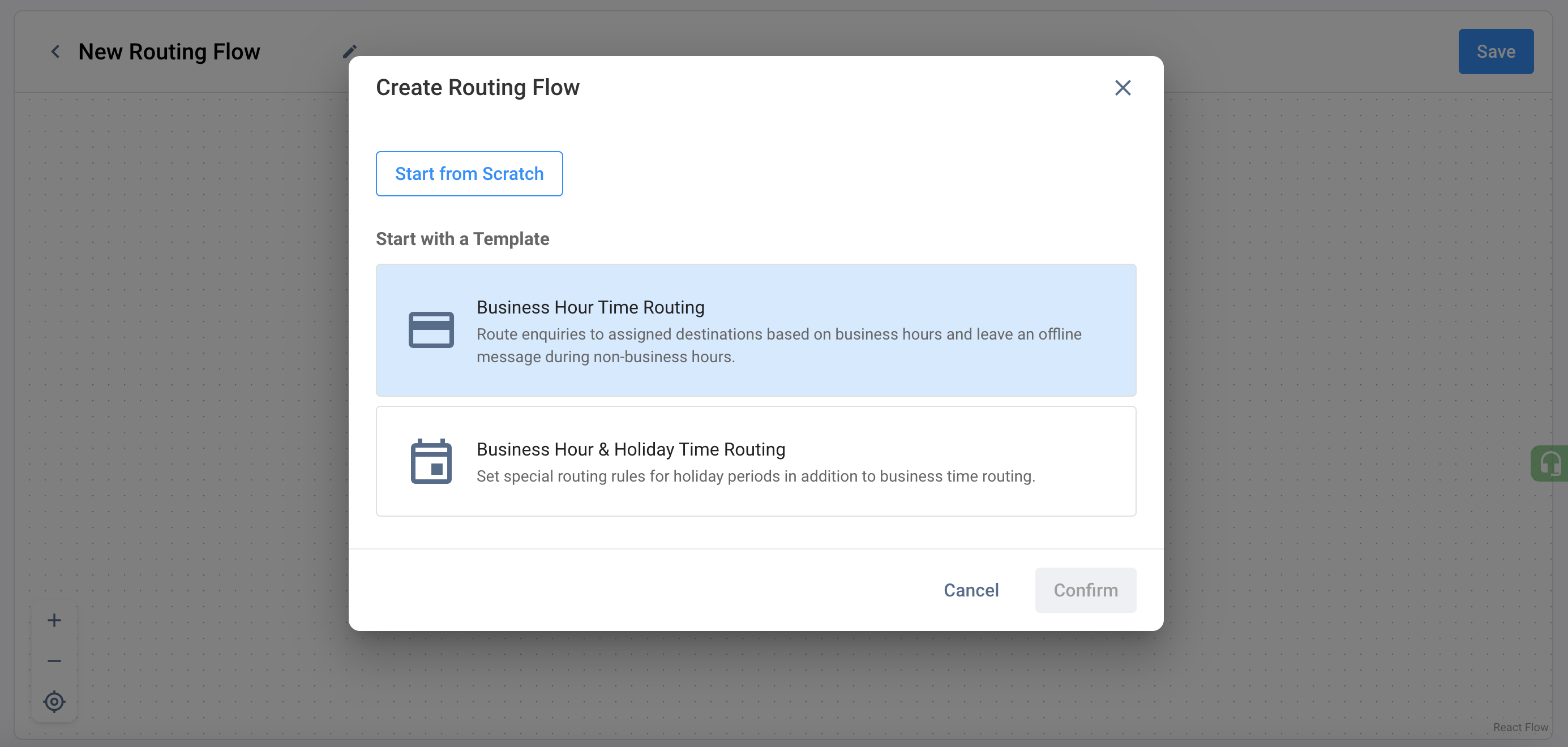
For the first time creating a routing flow, it is recommended to start with a template.
Select for the template and click Confirm
Business Hour Time Routing
Route enquiries to assigned destinations based on business hours and leave an offline message during non-business hours.
- The trigger point begins When a visitor initiates an enquiry
- The action Time & Schedule
- A-1. New Schedule - every Mon, Tue, Wed, Thu, Fri from 09:00 - 17:00
- A-2. Other Time - means the rest of Time from 09:00 - 17:00
- Adjust the Time and Schedule according to your support operation.
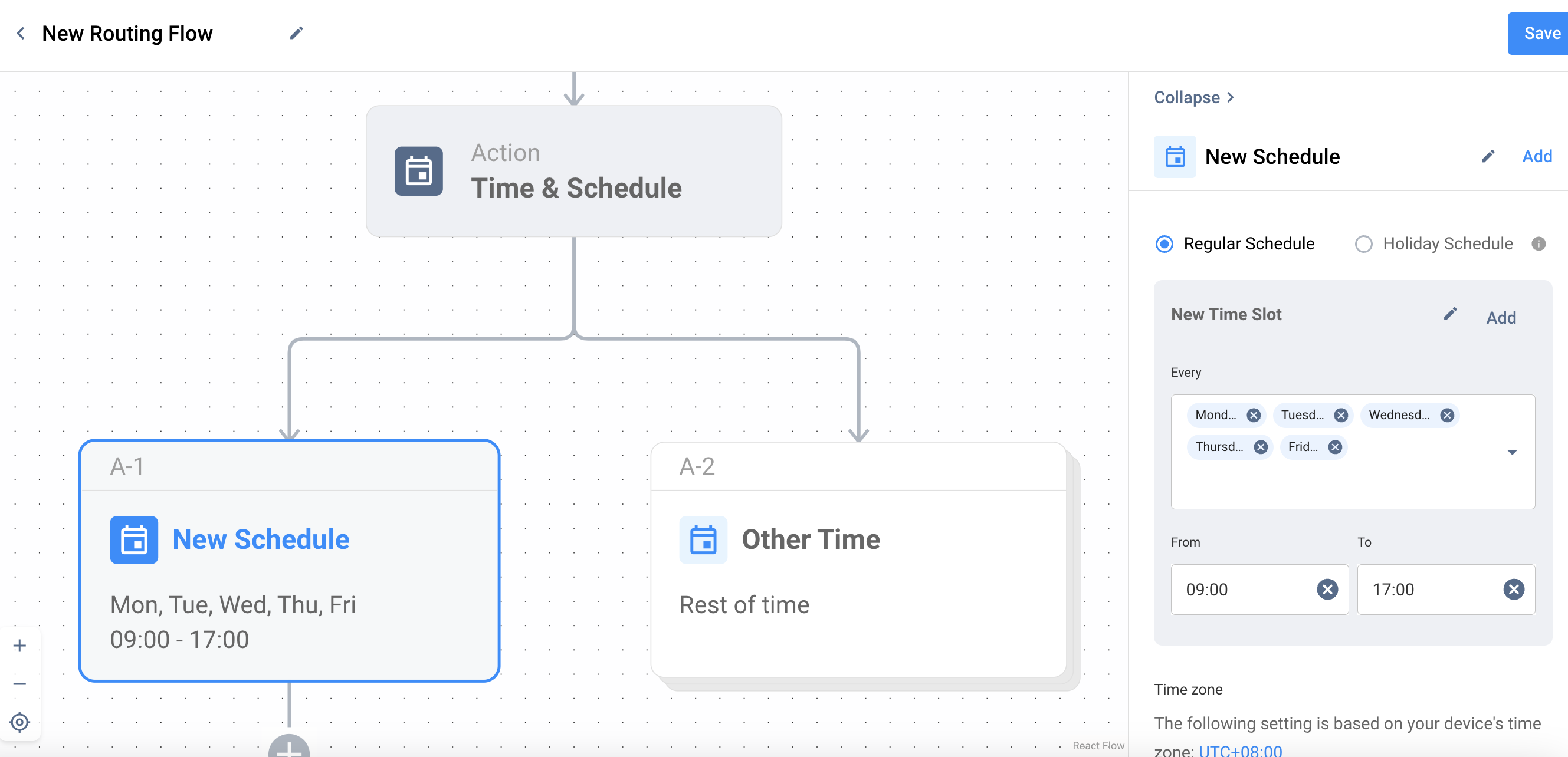
- New Schedule - Prompt - a greeting prompt is set up for the new Schedule.
- The Other Time is routed to the Voicemail prompt with Missed Enquiry. Feel free to adjust it by clicking + in the visual flow.
- Then, continue setting up the routing flow by clicking + and selecting using time routing, adding IVR, Queue, prompt or IVR, and changing the enquiry status, for example, to miss or close an enquiry. Please refer to Routing Flow Components to continue.
- Complete the set-up with the settings form on the right side for each selected flow. Click the Save button to save your routing flow successfully.
Business Hour & Holiday Time Routing
Set special routing rules for holiday periods in addition to business time routing.
-
The trigger point begins When a visitor initiates an enquiry
-
The action Time & Schedule
- A-1. New Schedule - every Mon, Tue, Wed, Thu, Fri from 09:00 - 17:00, free to adjust the day and time
- A-2. New Schedule - set up the Schedule as a regular or holiday schedule.
- A-3. Other Time - means the rest of Time of A-1 and A-2 schedules.
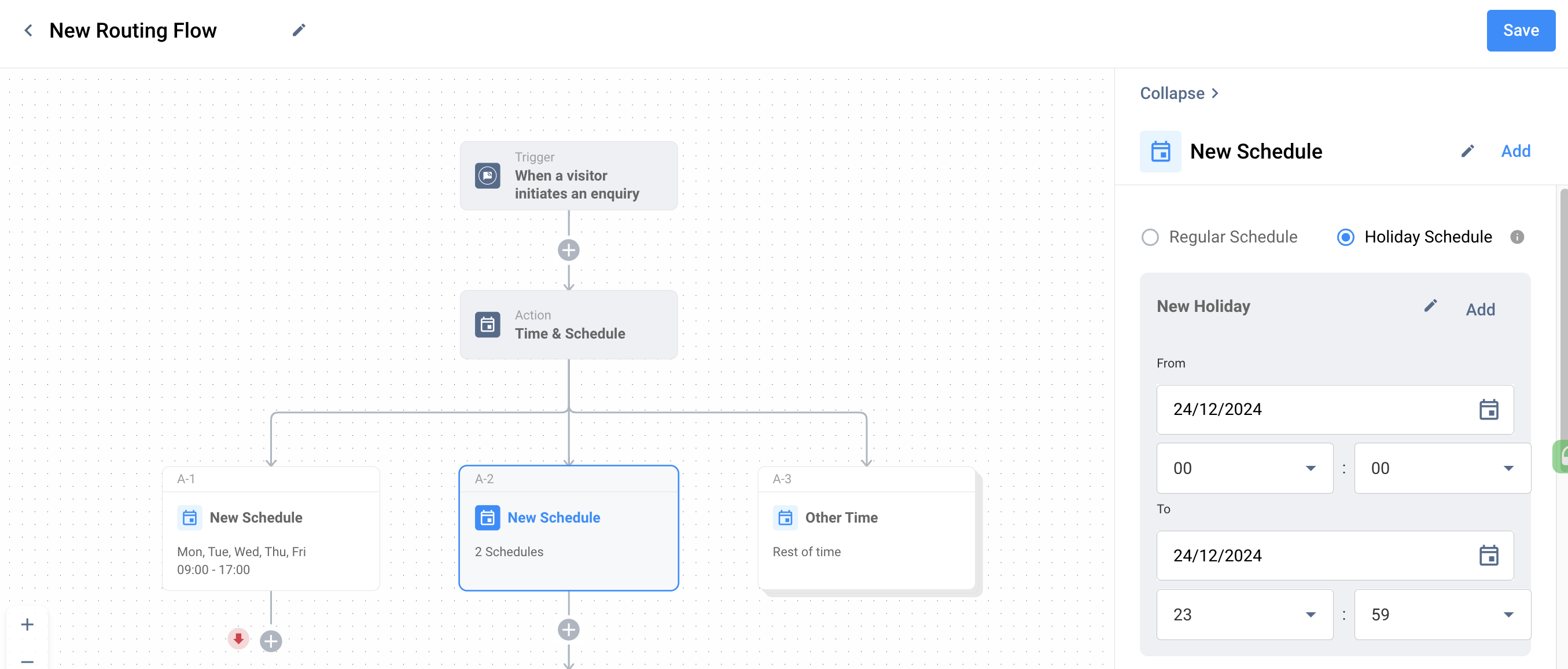
-
Adjust the Time and Schedule according to your support operation.
-
Then, continue setting up the routing flow by clicking + and selecting using time routing, adding IVR, Queue, prompt or IVR, and changing the enquiry status, for example, to miss or close an enquiry. Please refer to Routing Flow Components to continue.
-
Complete the set-up with the settings form on the right side for each selected flow. Click the Save button to save your routing flow successfully.
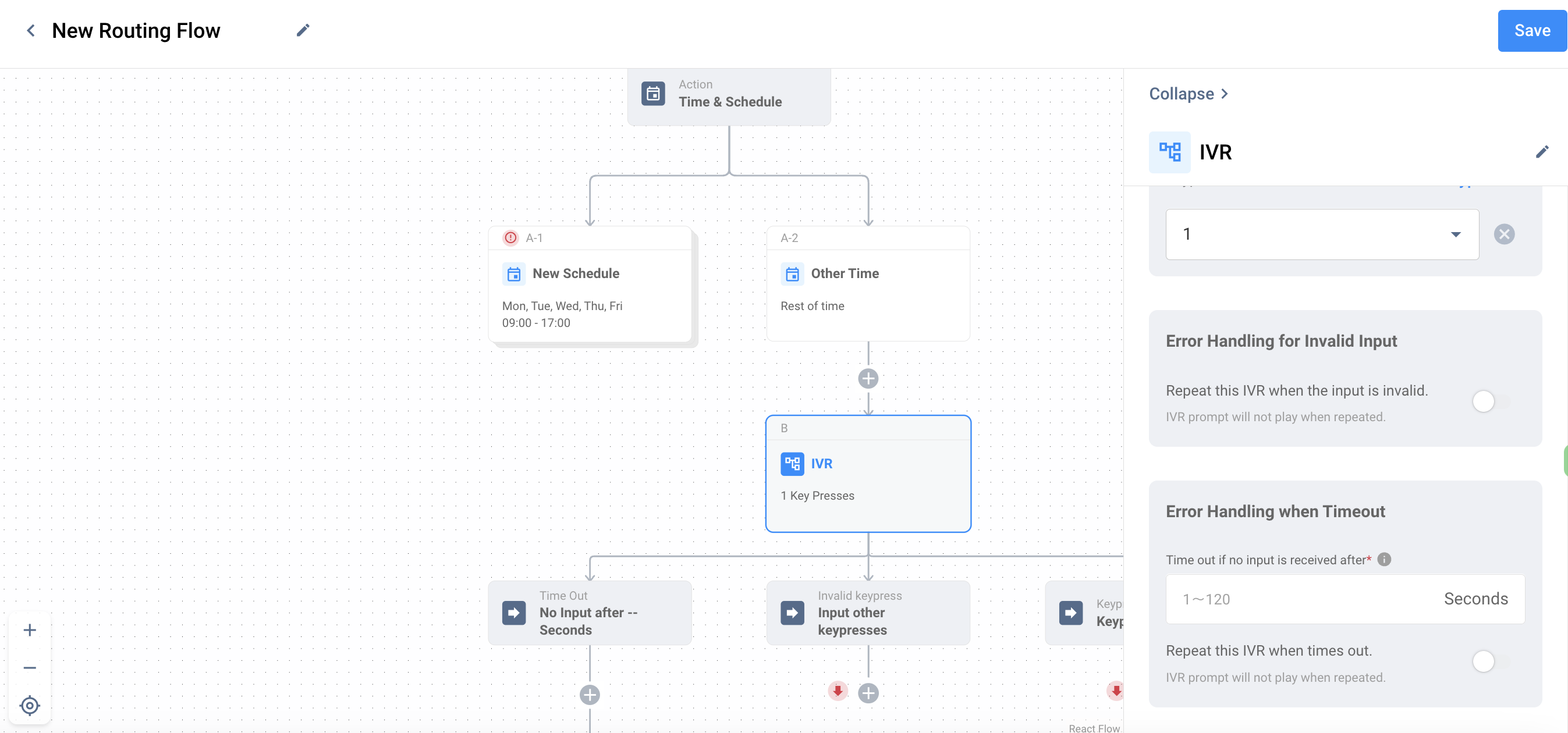
Start from Scratch
- The trigger point begins When a visitor initiates an enquiry
- Then, continue setting up the routing flow by clicking + and selecting using time routing, adding IVR, Queue, prompt or IVR, and changing the enquiry status, for example, to miss or close an enquiry. Please refer to Routing Flow Components to continue.
- Complete the set-up with the settings form on the right side for each selected flow. Click the Save button to save your routing flow successfully.
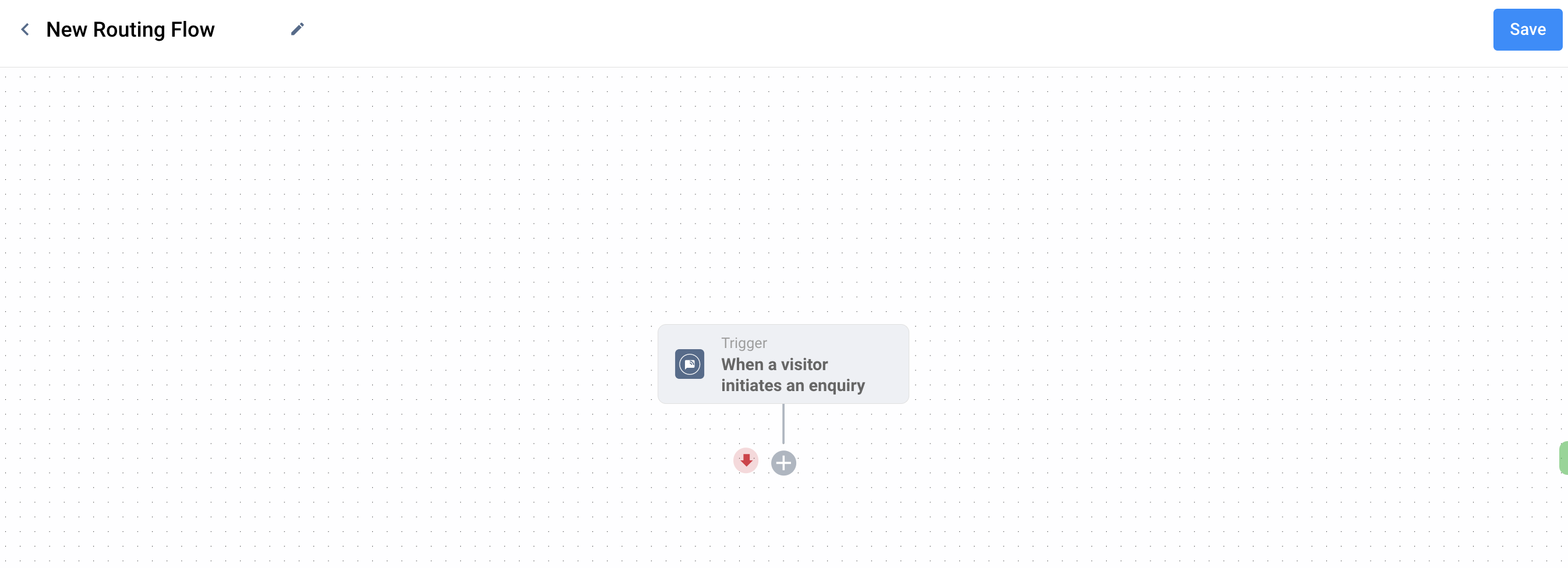
Routing Flow Components
Time Routing (Scheduling)
Time Routing, also known as scheduling, allows you to define specific time slots for routing new enquiries. It lets you allocate Time within your regular or holiday Schedule, considering particular days and time slots. The time zone used for scheduling follows the time zone settings of your device.
-
Regular Schedule
- In the regular schedule section, you can set up recurring time slots for routing enquiries during typical working days. For example, you can allocate a new time slot every Monday to Friday from 09:00 to 17:00. New enquiries will be routed within this time frame on weekdays, providing a predictable schedule for your team and ensuring timely handling of requests.
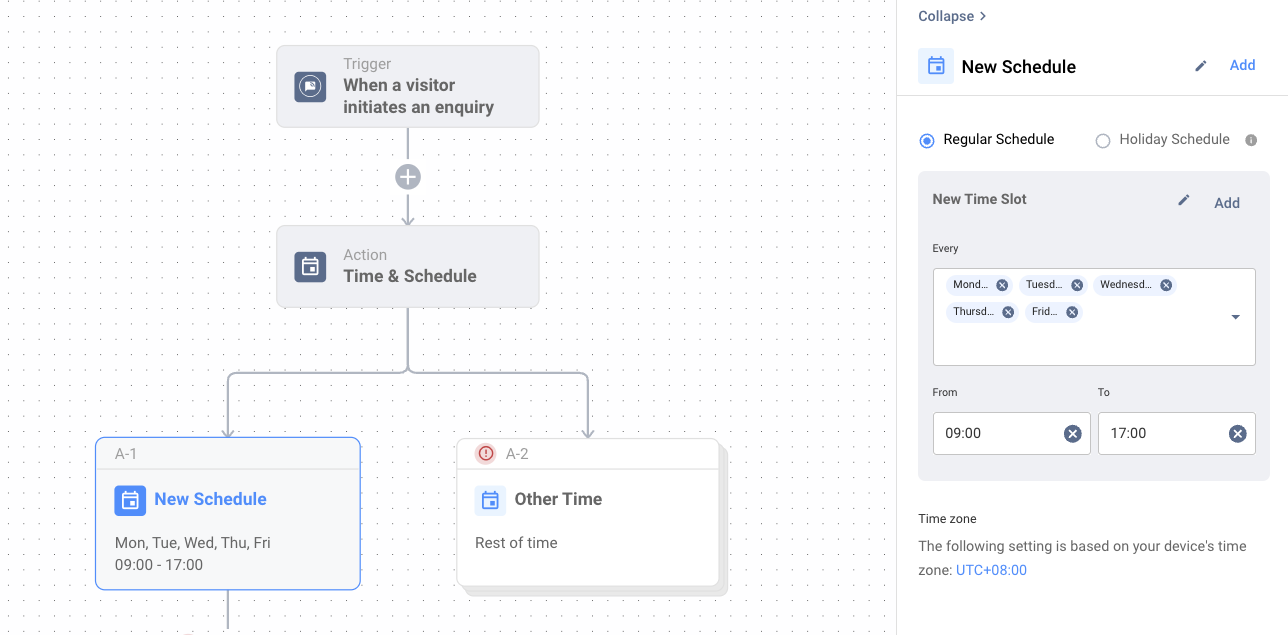
- Holiday Schedule
- The holiday schedule allows you to customise Routing based on specific dates, such as public holidays or special occasions when your team might have different availability. Adding holiday schedules to the routing flow allows you to account for these exceptional periods and adjust the time slots accordingly.
- For instance, let's consider December 25th, 2024, as a holiday. You can define a time slot for that particular date, from 00:00 to 23:59, indicating that routing enquiries should follow this Schedule exclusively on that day.
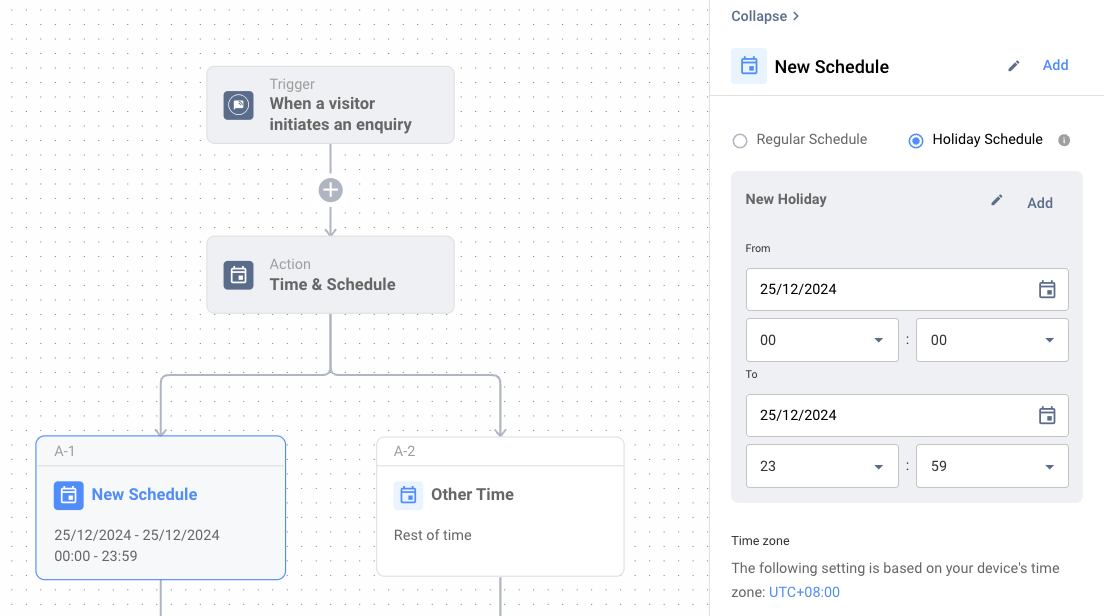
-
Other Time
- Other Time refers to the remaining Time not covered by the regular and holiday schedules in the time routing system. It includes time slots outside the specified regular working hours and holiday periods.
- For instance, if your regular Schedule is from Monday to Friday, 09:00 to 17:00, and you have defined specific holiday schedules for certain dates, any time slots outside these predefined schedules would be considered "Other Time." This could include weekends or after-hours periods when routing tasks might occur.

You can ensure efficient task allocation and effective workload management by incorporating regular and holiday schedules and other time into your time routing system. This feature lets you align routine activities with your team's availability and optimise enquiry productivity based on predefined time slots.
Queue
A queue in enquiry management is a waiting line where customers are placed when contacting customer service. It efficiently handles and prioritises customer interactions, organising enquiries from various channels until an agent can assist, ensuring fairness and order in managing customer interactions. The following details will appear in the Routing Flow for using Queue to handle enquiries accordingly.
- Distribution Method (Simultaneous, Most Idle or Round Robin)
- Max Enquiries in Queue
- Max Hold Time
- Endpoint (Agent) Ringing Timeout
- Staff List (Endpoint)
To use the Queue in the Routing, please create a Queue first. Refer to our detailed guide for more details.

IVR
IVR stands for Interactive Voice Response, a technology in enquiry management systems that enables automated caller interaction through pre-recorded voice prompts and keypress inputs. IVR systems allow callers to navigate menu options using their telephone keypad.
In enquiry management with keypress configuration, timeout, and invalid key press with prompt, the IVR system provides specific prompts and responses based on the caller's keypress inputs.
- Add an IVR by clicking the + plus icon and selecting Add IVR > Add IVR Task. The IVR tree will be added to the flow with the following:
- Time Out
- Invalid Keypress
- Keypresses
You will need to configure its flow setting in the right-hand menu.
- Time Out - Add an IVR prompt related to timeout to the right-hand menu. Adding a new prompt, a better tone, and a better message is better that fits your brand.
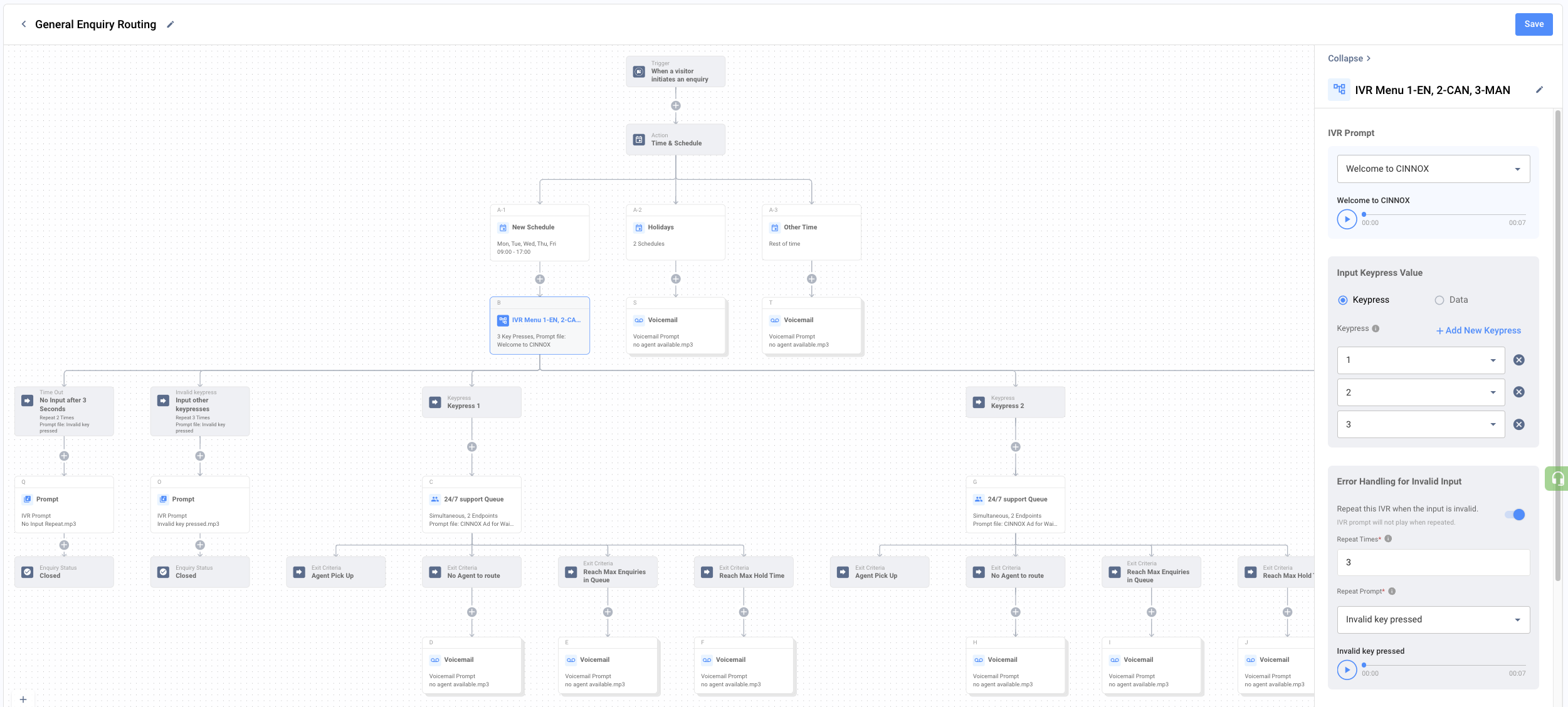
Prompt
Prompts are audio files, or text-to-speech played at various points within the call process, such as:
- Greeting Prompt
- End Prompt
- IVR Prompt
You can use a prompt for a call enquiry while the customer waits in line.
- Greeting prompt - preselect the default greeting or add a new one. New prompt creation could be by:
- Audio File
- Text-to-Speech
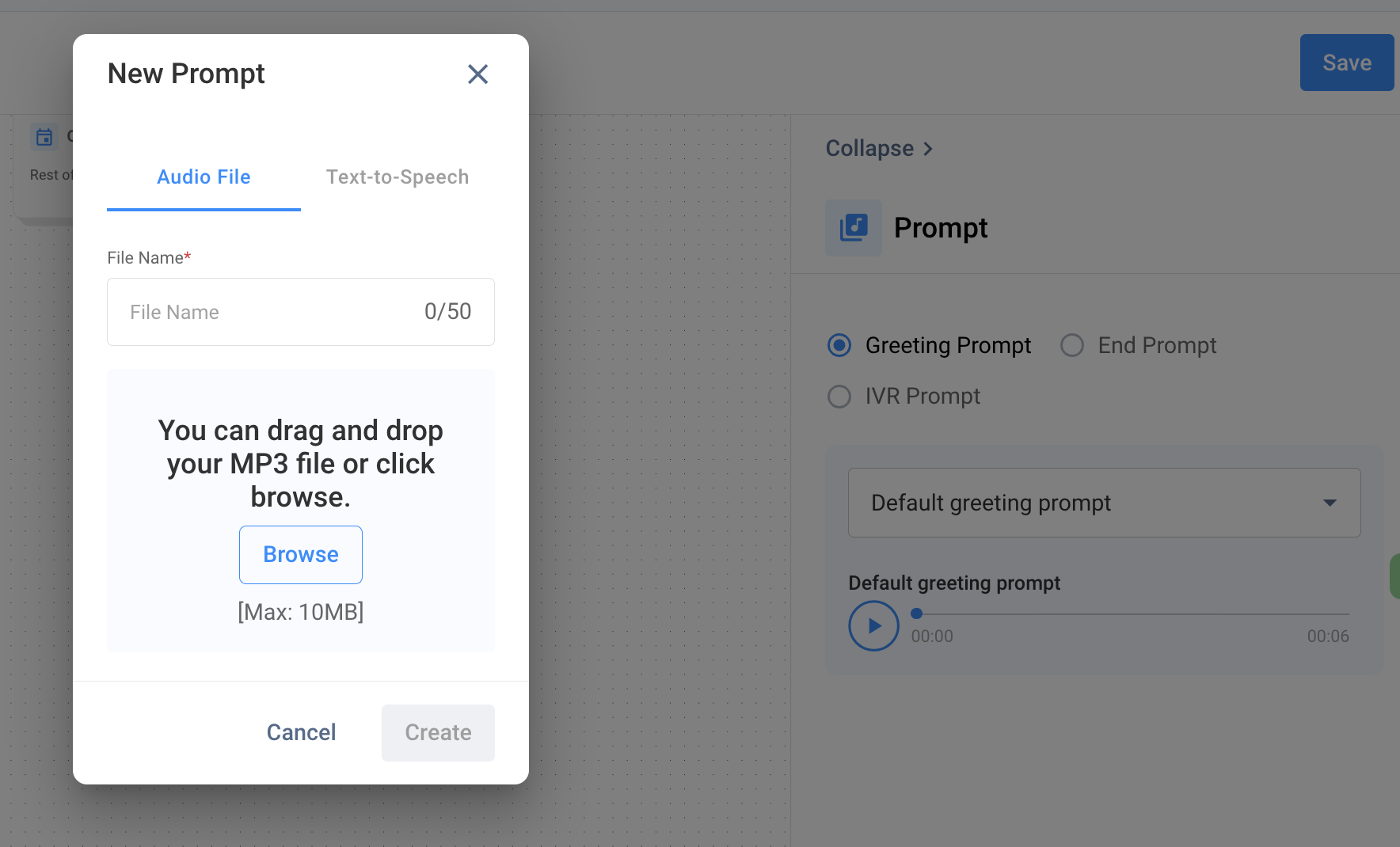
The prompt is mostly used for the IVR menu and when ending the call.
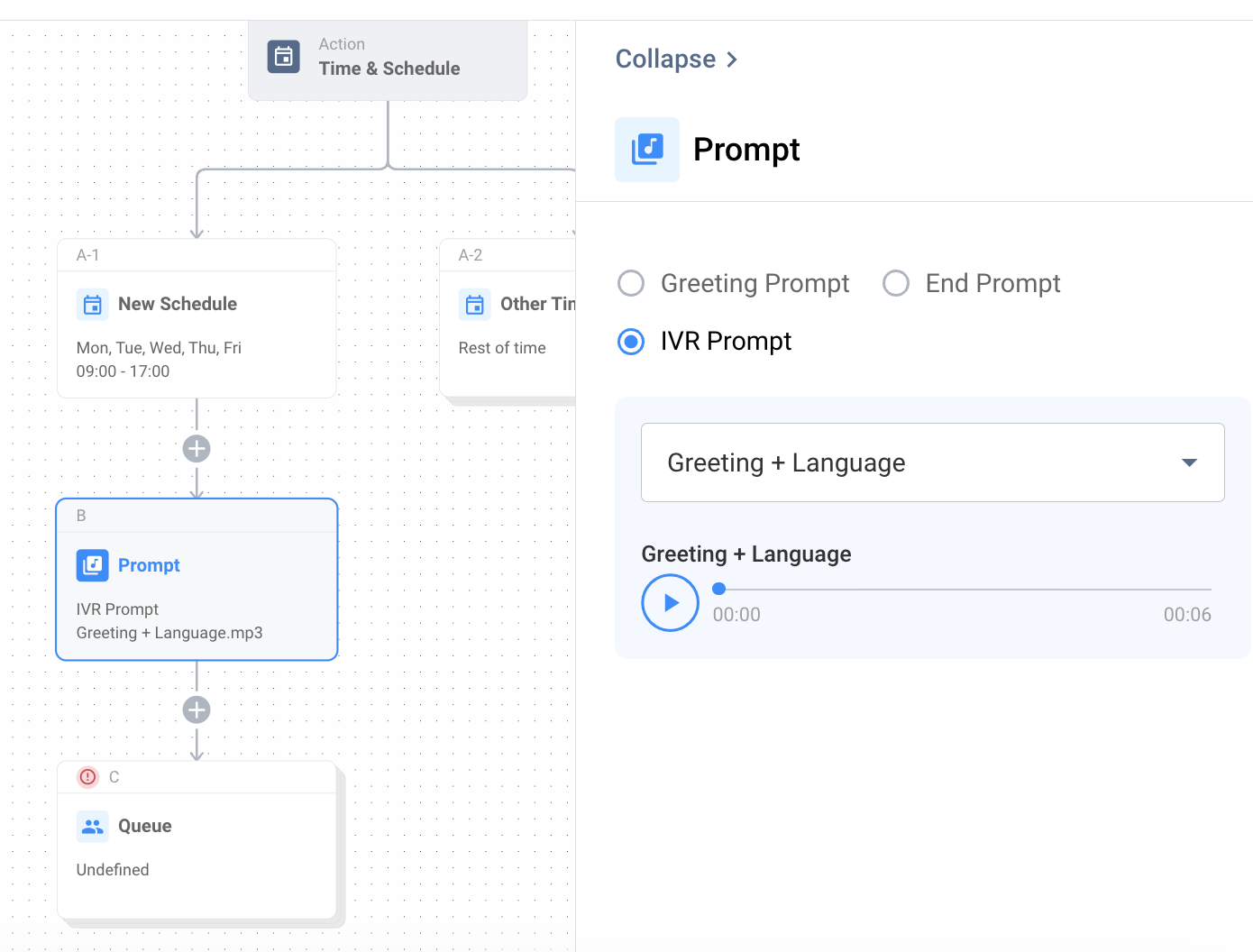
Voicemail
Voicemail lets your customers leave you a voice message when your agents cannot answer their call enquiry.
- You can set the voicemail and then preselect the default prompt or add a new one.
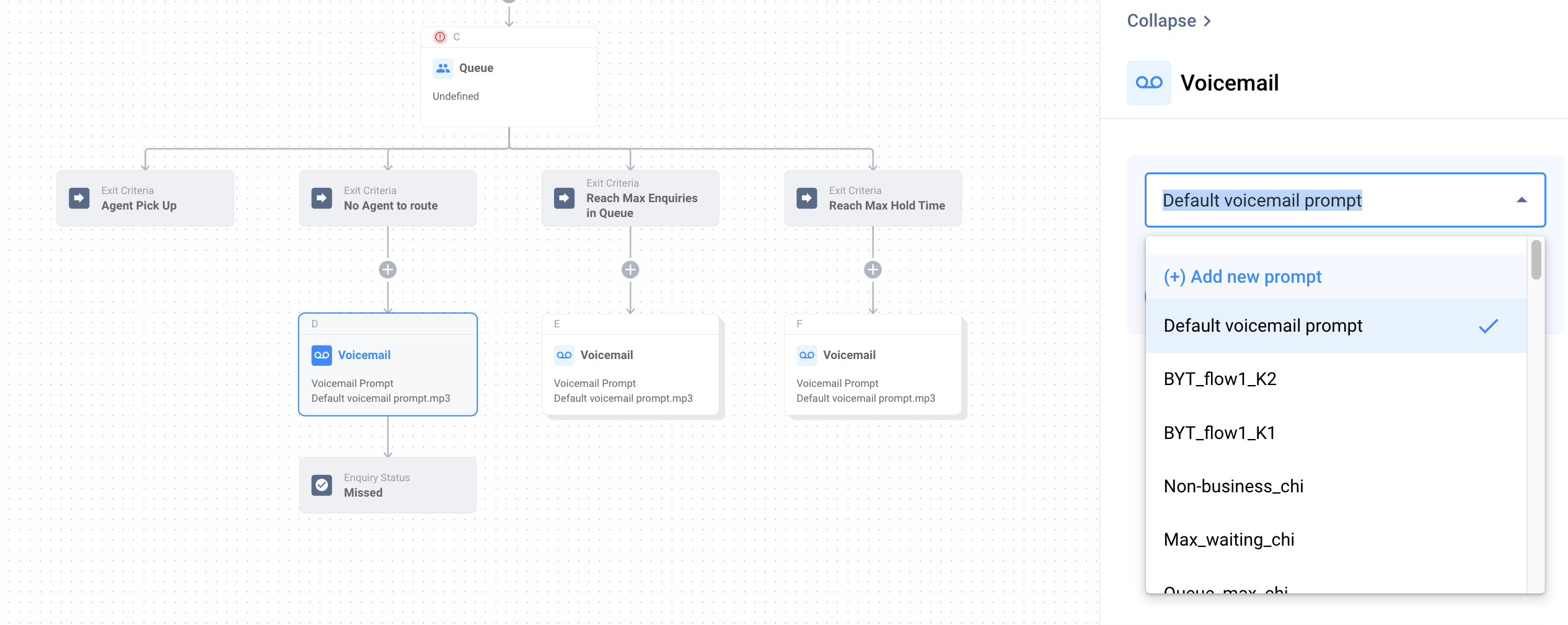
- Voicemail is usually on the last flow, and then the call enquiry status will become Missed, and the call will end.
Change Enquiry Status (Exit Criteria)
- For each flow that has been added to the Routing, there will be exit criteria to end the flow and call:
- Either use voicemail, and the enquiry will be missed
- Or, change the enquiry to Missed or Closed for cases with no keypress input from callers or the keypress is invalid after several IVR flow repeats.
- Click + and select Change Enquiry Status > then Missed Enquiry or Closed Enquiry.
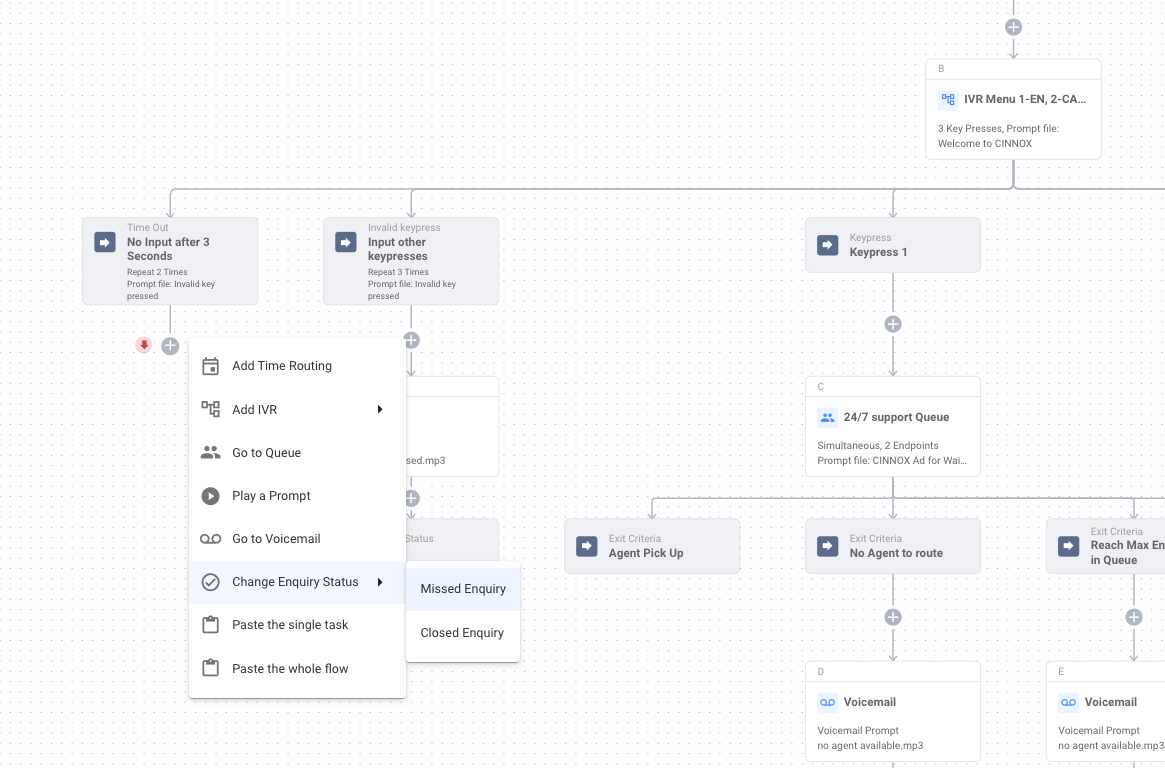
NoticeAnother entry point to access Routing Flow is via Administration > Channels > Routing Flow.
Updated 6 months ago